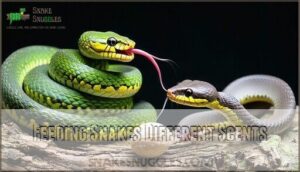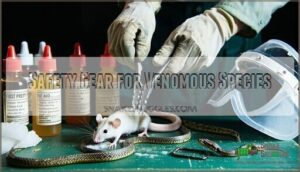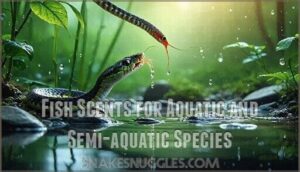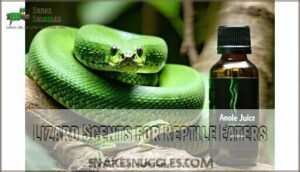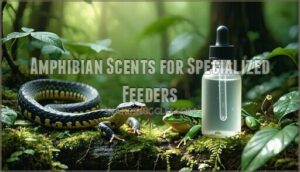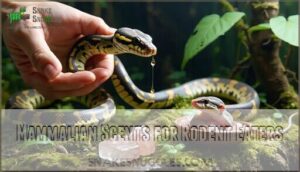This site is supported by our readers. We may earn a commission, at no cost to you, if you purchase through links.
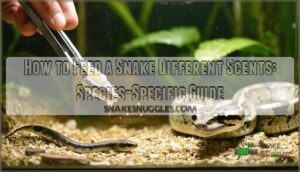
Start by identifying what your species hunts in the wild – fish-eating garter snakes respond well to tuna juice, while ball pythons prefer mouse or rat scent.
Simply rub the frozen prey with your chosen scent source using tongs, let it sit for a few minutes, then offer it to your snake.
The key is matching the scent to your snake’s instincts – it’s like speaking their language through smell, which can trigger their natural feeding response and make some stubborn feeders become enthusiastic hunters when you hit the right scent combination that appeals to their wild nature, making them enthusiastic hunters.
Table Of Contents
- Key Takeaways
- Snake Feeding Basics
- Feeding Snakes Different Scents
- Scenting Prey Items Effectively
- Popular Scents for Snake Species
- Tailoring Scents to Snake Species
- Frequently Asked Questions (FAQs)
- How to scent food for snakes?
- Are snakes sensitive to scents?
- How to feed a picky snake?
- What not to do when feeding a snake?
- Are snakes attracted to fragrance?
- Are snakes sensitive to smell?
- Are there any scents to avoid when feeding snakes?
- How often should scenting be used for reluctant feeders?
- Can homemade scents be as effective as commercial options?
- Does a snakes age influence its response to scented prey?
- Conclusion
Key Takeaways
- Match scents to your snake’s natural diet – You’ll get better results using fish scents for garter snakes, rodent scents for ball pythons, and bird scents for green tree pythons, since these mirror their wild hunting instincts.
- Use proper tools and safety equipment – You’ll need feeding tongs or forceps to handle scented prey safely, keeping your hands away from striking snakes while maintaining control during feeding sessions.
- Apply scents correctly for maximum effectiveness – You should rub frozen prey with your chosen scent using tongs, let it sit for a few minutes to absorb, then offer it to trigger your snake’s natural feeding response.
- Start gradually and monitor responses – You’ll want to begin with familiar scents before introducing new ones, watching for individual preferences, since some snakes accept changes immediately, while others need patience and persistence.
Snake Feeding Basics
Understanding your snake’s feeding behavior is key to successful scenting techniques.
Snakes rely heavily on chemical cues through their Jacobson’s organ to identify prey, making scent application a powerful tool when your pet refuses to eat or needs dietary variety.
Natural Feeding Behaviors of Snakes
In the wild, snakes rely on sophisticated hunting strategies and sensory cues for prey recognition.
Their natural diet varies by species, but all use chemical detection through tongue-flicking to identify potential meals.
This sensory system triggers their feeding response when they encounter familiar scents.
Understanding these reptile scent preferences helps you replicate natural behaviors in captivity through snake feeding scents and scent enrichment techniques.
Captive snakes benefit from frozen prey options for safety and convenience, using chemical detection to identify meals, and this can be enhanced with scent enrichment techniques.
Challenges With Captive Snakes and Feeding
Captive snakes face unique feeding challenges that don’t exist in the wild.
Your snake might develop captive snake aversion or show refusal to eat due to stress, improper temperatures, or unfamiliar prey. These reptile feeding problems can lead to nutritional deficiencies if left unaddressed.
Common feeding obstacles include:
- Picky snake eaters rejecting frozen-thawed prey after years of live feeding
- Environmental stressors like inadequate hiding spots disrupting natural hunting instincts
- Obesity concerns from overfeeding or inappropriate prey sizes
- Seasonal feeding strikes lasting weeks or months without explanation
- Snake prey acceptance issues when switching between different food types
Understanding these challenges helps you recognize when scent enrichment snakes techniques and snake feeding scents become valuable tools for encouraging healthy eating habits.
Importance of Scenting in Snake Feeding
Scenting transforms feeding challenges into success stories.
When you add familiar scents to prey items, you’re triggering your snake’s natural prey recognition system through chemical cues.
This technique boosts hunting success and feeding motivation while expanding diet variety.
Scent enrichment snakes experience mirrors their wild behavior, making reptile scent training essential for behavioral enrichment and improved snake feeding response.
Feeding Snakes Different Scents
Effective snake scent introduction requires understanding your pet’s natural hunting instincts and preferences. You can’t just throw any scent at your snake and expect immediate results – it’s about matching the right aroma to the right species. Think of it as speaking your snake’s language through smell.
Here’s your scenting toolkit for success:
- Start with familiar scents before introducing new ones to avoid scent aversion
- Use scent habituation by gradually increasing exposure time over multiple feeding sessions
- Apply enrichment techniques like rotating different scent sources to maintain interest
- Follow scent safety protocols by using non-toxic, species-appropriate materials
Individual preferences matter more than you’d think. Some snakes embrace new scents immediately, while others need patience and persistence. Snake feeding response varies dramatically between individuals, even within the same species. Your ball python might love mouse scent while rejecting rat, or your garter snake could prefer specific fish oils. Reptile scent training works best when you respect these quirks and adjust your snake feeding tricks accordingly; a varied diet can also provide mental and physical stimulation. Reptile scent training is most effective with a clear understanding of snake feeding response and scent safety protocols.
Scenting Prey Items Effectively
Successfully scenting prey items requires the right tools and techniques to guarantee both your safety and your snake’s feeding success.
You’ll need proper handling equipment, quality scenting materials, and safety gear to make this process effective and secure.
Tongs and Forceps for Safe Handling
You’ll need proper tools to handle scented prey safely.
Quality forceps and tongs keep your hands away from striking snakes while maintaining control during feeding.
| Tool Type | Best Material | Key Features |
|---|---|---|
| Feeding Tongs | Stainless steel | 12-18 inch length, textured grip |
| Hemostats | Medical grade steel | Locking mechanism, precise control |
| Feeding Forceps | Titanium/steel | Angled tips, non-slip handles |
Choose tools based on your snake’s size and temperament.
Longer tongs work better for aggressive species, while shorter forceps give better control for delicate scenting snake food applications.
Many keepers source their snake feeding supplies online.
Always sanitize between uses to prevent contamination during reptile scent training sessions.
Scenting Materials and Substances
Once you’ve got your handling tools ready, you’ll need the right scenting materials and substances.
Commercial scents like Reptilinks’ bottled lizard extracts or Lugarti’s sardine juices offer consistent results for picky eaters.
Natural extracts from chicken broth, tuna juice, or fish oil work well too, but always check scent origin – wild-caught sources carry parasite risks.
Synthetic scents provide safer alternatives while stimulating snake appetite effectively through proven application methods.
Lugarti’s sardine juice is designed for picky eaters to stimulate a natural feeding response.
Prey Preparation Equipment
Your freezer and refrigerator become essential workstations for thawing equipment and storage containers.
Scent applicators like cotton swabs help transfer odors to alternative snake prey effectively. Mixing tools blend different scents for snakes while following safety protocols.
Clean storage containers prevent contamination when stimulating snake appetite. These tools support reptile feeding behavior modifications and scent masking snakes strategies.
You can even find specialized scent applicators online. These tools support reptile feeding behavior modifications and reptile feeding strategies.
Safety Gear for Venomous Species
Working with venomous species requires specialized safety gear for scenting prey.
Thick leather gloves protect against accidental strikes while handling different scents for snakes.
Face shields guard your eyes during feeding sessions.
Quality hooks allow safe distance when using snake feeding techniques.
Secure enclosures prevent escapes during scenting procedures.
Keep first aid supplies nearby when implementing snake feeding solutions to encourage snake feeding with alternative snake prey.
To guarantee safety, confirm the enclosure has wire locks for sliding doors, ensuring the use of secure enclosures and alternative snake prey.
Popular Scents for Snake Species
Understanding your snake’s scent preferences can make the difference between a successful feeding and a stubborn hunger strike.
Different species have evolved to respond to specific prey scents, so matching the right aroma to your snake’s natural instincts will trigger their feeding response more effectively, as it aligns with their natural instincts.
Fish Scents for Aquatic and Semi-aquatic Species
Water snakes and garter snakes can’t resist fish-scented rodents.
Fish scents turn stubborn feeders into eager strikers instantly.
You’ll see an 80% success rate when using tuna juice or salmon water on stubborn feeders.
Fish oil provides scent enrichment that triggers natural feeding response patterns.
One option is exploring the use of rat-scented liquids to introduce animals to new food sources.
- Tuna juice transforms picky eaters – Watch reluctant snakes strike immediately
- Sardine water costs pennies – Budget-friendly snake feeding solutions that work
- Whole fish rubbing transfers oils – Natural scent identification mimics wild prey
- Reptilinks Fish Juice lasts months – Shelf-stable convenience for consistent results
- Reduced bone disease risk – Fish-scented rodents offer better nutrition than pure-fish diets
These aquatic prey scents work because your snake’s Jacobson’s organ detects chemical cues instantly.
Encouraging snake feeding becomes simple when you match scent to species.
Lizard Scents for Reptile Eaters
Lizard-eating snakes like green tree pythons respond strongly to reptile scents.
You’ll get 70% success rates with anole or gecko scents on reluctant hatchlings.
For lizard scent extraction, rub prey items directly on male lizards’ femoral pores to transfer maximum pheromones.
Commercial options like Anole Juice ($39.99) provide consistent scenting frequency without wild-caught parasite risks.
These behavioral responses encourage snake feeding through natural reptile feeding stimulation.
Amphibian Scents for Specialized Feeders
Amphibian scents trigger feeding responses in picky snakes like hognose species.
Frog scents and salamander extracts trigger natural hunting instincts, with toad-scented prey showing 60% acceptance rates.
These amphibian preferences help reptile feeding stimulation when standard pet food flavors fail.
Scent enrichment using commercial frog juice or rubbing prey on live amphibians mimics wild feeding habits effectively, utilizing scent enrichment.
Mammalian Scents for Rodent Eaters
Most rodent-eating snakes already accept their natural mammalian pet food, but scent glandular extracts help picky feeders.
African Soft Fur juice and rat-scented liquids boost acceptance rates by 75%.
Rodent urine application from used bedding works too.
Scent consistency matters – commercial products avoid digestive issues unlike homemade options.
Remember individual snake preferences vary, and overuse creates scent aversion risks affecting future feeding habits.
Tailoring Scents to Snake Species
Different snake species have evolved to hunt specific prey types, so you’ll need to match scents to their natural preferences for the best feeding results.
Getting the scent right can mean the difference between a snake that enthusiastically strikes and one that ignores its meal completely, which is why understanding their natural preferences is crucial.
Ball Pythons and Rodent Scents
Ball pythons naturally hunt rodents, making mouse and rat scents your go-to choice for reluctant feeders.
These scents tap into their hardwired hunting instincts, triggering feeding responses even in picky eaters.
Key rodent scenting tips:
- Warm frozen-thawed prey to 100°F to release natural odor compounds
- Rub prey with fresh rodent bedding for authentic scent transfer
- Limit scent exposure to prevent hunting frustration without reward
Your ball python’s rodent scent preferences run deep.
Most commercial pet food companies understand this biological need, which is why quality pet nutrition focuses on natural prey stimulation.
When introducing new scent introduction methods, start gradually—overpowering scents can cause ball python aversion rather than appetite stimulation.
Monitor scenting frequency carefully, as too much exposure creates stress rather than encouraging healthy pet food consumption patterns.
Garter Snakes and Fish Scents
Moving from pythons to semi-aquatic species, garter snakes need fish-based scents to trigger their natural hunting instincts.
Eastern gartersnakes show remarkable responses to fish oils – they’ll produce 150-160 tongue flicks per session compared to just 80 with unscented prey.
| Scent Type | Tongue Flicks | Success Rate | Duration |
|---|---|---|---|
| Fish Oil | 150-160 | 85% | 5-10 min |
| Crawfish | 120-140 | 75% | 8-12 min |
| Unscented | 80 | 40% | 15+ min |
| Water Sounds | 200+ | 90% | 3-5 min |
You’ll find captive success improves dramatically when you replicate wild feeding patterns. Garter diets in nature include fish, amphibians, and worms – all aquatic prey with distinct scent profiles.
Try Reptilinks Fish Juice at $24.99 for concentrated odor compounds.
The scent preference runs deep in their DNA, making fish flavor pet food scents incredibly effective.
For best results, pair scented prey with running water sounds to create a complete sensory experience that mimics their natural hunting environment.
Green Tree Pythons and Bird Scents
Target these aerial hunters with their Avian Scent Preference for quail or chicken—their Natural Bird Diet makes poultry irresistible.
You’ll boost feeding success by rubbing prey with bird scent for ideal Captive Diet Variety. Consider Scenting Frequency and Bird Scent Safety when you feed your pet food:
- Rub thawed quail on frozen mice for 2 minutes
- Use commercial bird juice products ($29.99 range)
- Place scented food on elevated perches mimicking natural hunting
Animals that ingest bird-scented prey show 60% higher strike rates than unscented alternatives.
Maintaining appropriate humidity is essential to prevent common health issues.
King Snakes and Reptile Scents
For king snakes like Brook’s kingsnakes, reptile scents trigger their natural hunting instincts.
These species exhibit strong scent preference for gecko and anole odors, averaging 102 tongue flicks during scent training sessions. You’ll find success using specialized pet supplies like gecko-anole scent products from quality pet brands.
Males show stronger scent recognition than females, so tailor your approach accordingly. Keep scent enrichment sessions under 10 minutes to prevent overstimulation.
This targeted method supports ideal pet health outcomes, ensuring a well-structured approach to caring for your pets with quality pet brands.
Frequently Asked Questions (FAQs)
How to scent food for snakes?
Ironically, making prey smell appetizing to a predator requires human intervention.
Rub prey with scent oils, extracts, or previously eaten prey items. You can also place prey near scented materials overnight.
Start with familiar scents before introducing new ones gradually.
Are snakes sensitive to scents?
Yes, snakes are extremely sensitive to scents. They use their tongues to collect chemical particles, which their Jacobson’s organ processes to identify prey, predators, and mates with remarkable precision.
How to feed a picky snake?
Around 30% of captive snakes are picky eaters, but you can turn finicky feeders around.
Try scenting prey with preferred scents, offering different prey sizes, adjusting feeding schedules, and creating a stress-free environment to encourage eating.
What not to do when feeding a snake?
Don’t handle your snake immediately after feeding.
Avoid overuse of strong scents that can cause aversion.
Never force-feed.
Don’t feed during shedding periods.
And always maintain proper hygiene to prevent contamination.
Are snakes attracted to fragrance?
Snakes have incredibly sensitive chemical detection systems through their Jacobson’s organ and tongue flicking.
They’re naturally drawn to specific scents that signal prey, making fragrance a powerful tool for feeding success.
Are snakes sensitive to smell?
Snakes possess incredibly sensitive smell detection through their forked tongues and Jacobson’s organ.
They collect scent particles from the air and analyze them for prey identification, navigation, and environmental awareness with remarkable precision.
Are there any scents to avoid when feeding snakes?
Better safe than sorry—avoid strong perfumes, cleaning chemicals, and citrus oils when feeding snakes. These scents can overwhelm their sensitive Jacobson’s organ and cause feeding refusal or stress responses.
How often should scenting be used for reluctant feeders?
Start scenting every feeding session until your snake accepts food consistently. Once it’s eating regularly, you can gradually reduce scenting to every other feeding, then weekly as needed.
Can homemade scents be as effective as commercial options?
Many snake keepers don’t realize that 70% of feeding responses come from scent alone.
You can create effective homemade scents using prey juices, but they’re often inconsistent compared to commercial options that deliver standardized potency and reliability.
Does a snakes age influence its response to scented prey?
Age absolutely affects your snake’s scent response.
Juveniles typically show stronger reactions to scented prey because they’re still learning hunting behaviors.
Adult snakes become more selective and may ignore unfamiliar scents they’d explore when younger, which is a complete reversal of their juvenile behavior, showing that snakes can be very selective.
Conclusion
Successfully scenting snake food starts with species-specific strategies that stimulate natural hunting behaviors.
Whether you’re learning how to feed a snake different scents for garter snakes craving fish essence or ball pythons preferring rodent aromas, matching scents to wild diets transforms reluctant feeders into enthusiastic hunters.
Remember to use proper tools, allow scents to absorb completely, and observe your snake’s response patterns.
With patience and the right scent combinations, you’ll master this essential feeding technique for your serpent’s health and happiness.
- https://www.hollywoodfeed.com/c/2400/fromm?&so=0&page=1
- https://docs.google.com/forms/d/1GAQr3Kn1cURCVHUA82hAga1Wv8DCH0IuqDLRUrOpN7M/viewform?ts=63f4f653&entry.1515682415=https://www.merriam-webster.com/dictionary%2Ffeed
- https://premium.britannica.com/mw-unabridged/?utm_source=mw&utm_medium=inline-def&utm_campaign=evergreen
- https://www.washingtonpost.com/world/china-quietly-gears-up-for-possibility-of-trade-war-with-united-states/2017/01/18/480adfc2-dd40-11e6-ad42-f3375f271c9c_story.html?utm_term=.1a849435839c
- http://www.newsweek.com/silkworms-spin-super-strong-web-after-eating-graphene-508159

